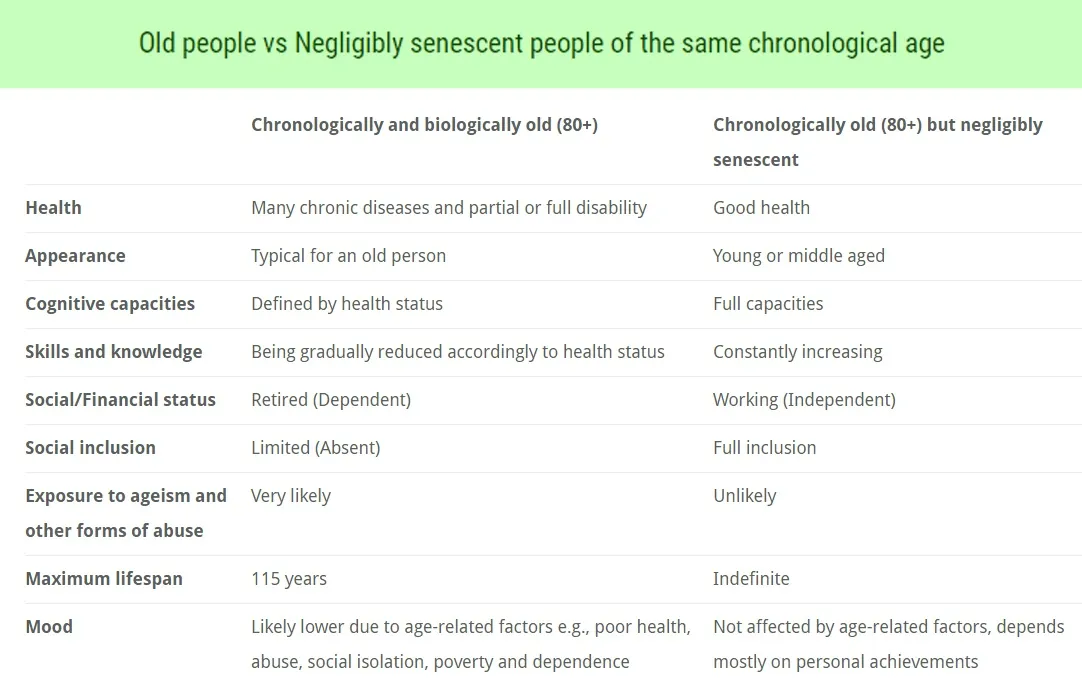Is Increasing the Human Lifespan Unnatural?
Whenever the topic of any possible increased healthy longevity through science is discussed, a common objection to developing the technology is that it is unnatural.
This argument usually arises during discussions of therapies that directly address the various processes of aging, and it is important to understand their basis and the reasons behind this line of thought.
The word ‘unnatural’ conjures up feelings of doom and dread, and it is unfortunately often used by critics of science as a way to justify their concerns. The argument is that interfering with the natural order of things is wrong and against nature; therefore, increasing healthy longevity with scientific advancements is something that we should not be doing. This classical argument is also sometimes referred to as “playing God”.
However, is it rational to talk about “natural” and “unnatural”, and do these terms really have any meaning? Let’s take a look at these concerns from a scientific point of view and see what their bases are.
What do we mean when we say “natural”?
Concepts like ‘natural, organic food is better’, ‘natural remedies are always the best option’, and so on, are all deeply ingrained into many belief systems. Therefore, it is easy to understand why some people consider advanced medicines and next-generation therapies to be somehow unnatural.
However, the Oxford Dictionary and other dictionaries give us the following relevant definition for the adjective “natural”:
Existing in or derived from nature; not made or caused by humankind (having had a minimum of processing or preservative treatment, having a characteristic of the unprocessed state).
If we look closer, this definition does not necessarily imply that natural is always good or indeed that artificial is always bad. Natural disasters are a bad thing, while artificial respiration techniques and artificial light are rather useful. We clearly need another tool to assess a thing in order to determine how good or bad it is for us.
Naturality and ethics
As this objection often makes a connection between naturality and ethics, let’s examine this first.
Ethics are moral principles that govern a person’s behavior or how a person conducts an activity, and the term is also defined as a branch of knowledge that deals with moral principles. The term “moral” refers to a lesson that can be derived from a story or experience or corresponding standards of behavior.
Thus, the existing system of ethics represents our accumulated knowledge about the world and the most useful strategies to ensure our well-being. This knowledge has crystallized into laws and science.
The amount of human knowledge is very large:in 2010, Google calculated the number of unique books that exist in the world, and it was around 130 million. No human being is able to soak up all this knowledge. In order to use vast amounts of information, we humans invented the division of labor and the system of specialized education. This allows us to distribute the information among ourselves and limit the amount an individual has to learn.
However, this approach has a dark side. While some people can be top specialists in one field, they can be ignorant in another. This is why, in order to make wise decisions in a field outside of our own profession, we need to rely on the data provided by others or to learn this second profession.
We tend to decide if things are ethical or unethical based on the limited information we have, although after investigating the subject fully, we may well change our opinion to the opposite.
For instance, there are people who are concerned about the side effects of vaccines, about the rare, adverse effects, and even about the deaths of some patients. These people protest that it is unethical to make vaccination obligatory for children.
Of course, the quality of the vaccines must be ensured and, where possible, improved to reduce the number of accidental deaths. However, what is the bigger picture here? What are the statistics on global morbidity and mortality because of preventable infectious diseases compared to immunization? Let’s look at some examples.
In the middle of the 20th century, before the global project for smallpox vaccination in 1967 began, smallpox killed approximately 50 million people each year (1 in 4 infected people), and it also made a significant share of survivors blind (up to 30%). The last natural case of smallpox occurred in Somalia in 1977, and the last accidental case happened in a laboratory in the United Kingdom in 1978.
In 1980, the global eradication of smallpox via vaccination was officially certified by the World Health Assembly. It was achieved in 13 years! While a few people have suffered from the side effects of the vaccine, tens of millions of lives have been saved, and all 7 billion people are now protected against this severe disease.
There is hope that the same statement will be made in the next few years about polio. There is no cure for polio; it can only be prevented. Back in 1988, before the global initiative to eradicate polio had begun, polio paralyzed more than 350,000 people every year, and about 5% of them died when the muscles of their respiratory systems were paralyzed. Only 74 cases were registered in 2015. Today, polio case numbers have decreased by more than 99% thanks to vaccination early in life.
The consequences of increased healthy longevity
When we try to assess the impact that increased healthy longevity might have on our society, it is useful to start with an evaluation of the current morbidity and mortality from age-related diseases.
Today, four main noncommunicable diseases (cardiovascular diseases, cancer, respiratory diseases, and diabetes) account for most deaths, killing about 100,000 people on Earth every day. There is no other factor that kills so many people: imagine 700 planes crashing every day or a city like Hiroshima being completely devastated every day!
It is clear that saving lives is good per se, but to evaluate its impact on human survival, we must look at this change from a larger perspective; what might be the long-term consequences?
First of all, let’s remember the goal of our community: to extend the healthy and productive period of life by addressing the aging processes. Here is a chart by aging researcher Michael Blagosklonny that illustrates the concept of moderate increased healthy longevity through innovative medical technologies [1].
If the aging processes are brought under some level of medical control, the period of subclinical aging could be extended, while the period of illness will be postponed, remaining the same length as before.
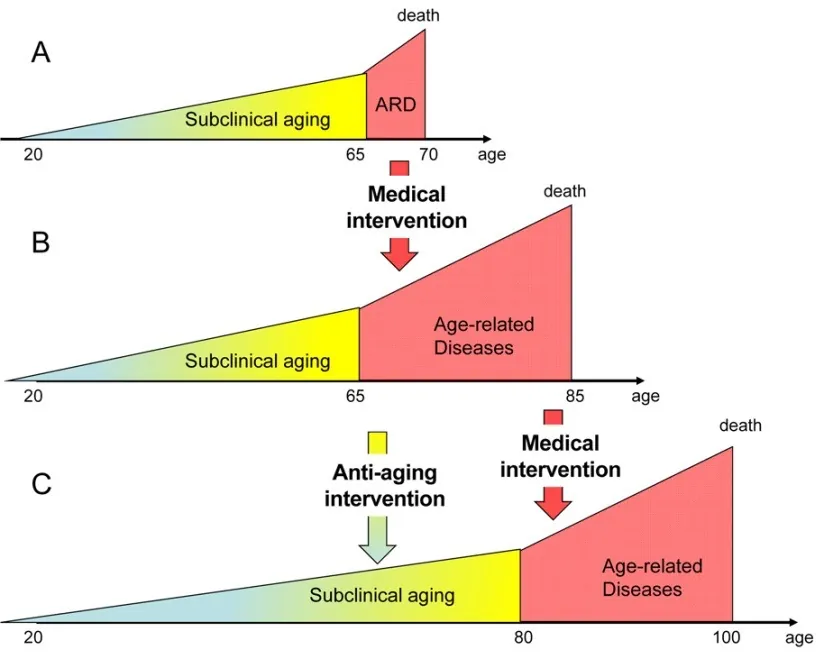
Fig 1. A: Pre Universal Medicine, B: Current medicine, C: Slowing aging. Source: Blagosklonny, M. V. (2012). How to save Medicare: the anti-aging remedy. Aging (Albany NY), 4(8), 547-52.
Additionally, if the various processes of aging can be brought under a decisive level of medical control, it would lead to so-called negligible senescence: a state in which deteriorative processes in the body are slower than reparative ones, enabling a person to stay healthy and young for an indefinite period of time.
If these kinds of technologies could be applied to an old person, whose health has already begun to deteriorate, it could potentially help the body to rejuvenate and get back to good health and a younger appearance. Here is the difference between chronologically and biologically old people and chronologically old but negligibly senescent people.
Fig 2. Old people vs negligibly senescent people of the same chronological age
While achieving negligible senescence is an extreme scenario, it is simple to demonstrate the benefits and challenges related to increasing healthy longevity in a more obvious way. We can expect several direct consequences of the introduction of negligible senescence technologies.
People would be free of age-related diseases and able to keep working
This means the workforce could double, including the workforce in science and engineering. As learning abilities will not be reduced with age anymore, humanity will likely become smarter and more skilled over time.
The loss of the most trained and knowledgeable professionals due to aging would cease, which should foster increased scientific and technological progress and economic development. This, in turn, could help humanity deal with new challenges in more efficient ways and solve emerging problems much faster.
The reduction of pension and healthcare expenditures
Pensions and government retirement programs, which are necessary today to support people who are unable to work due to deteriorating health, will not be necessary anymore. The freed-up money could then be redirected to support the education system to help people acquire new up-to-date professional skills for further personal development and more stable financial well-being.
Healthcare expenditures to treat age-related diseases would be removed, and the freed resources could be redistributed to help develop the global infrastructure to maintain negligible senescence for everyone, everywhere.
There could be population growth
The United Nations Population Prospects 2015 revision estimates that global population will increase until 2100, when the growth is likely to stop because of the decrease of birthrate, which is typical for the high level of economic development.
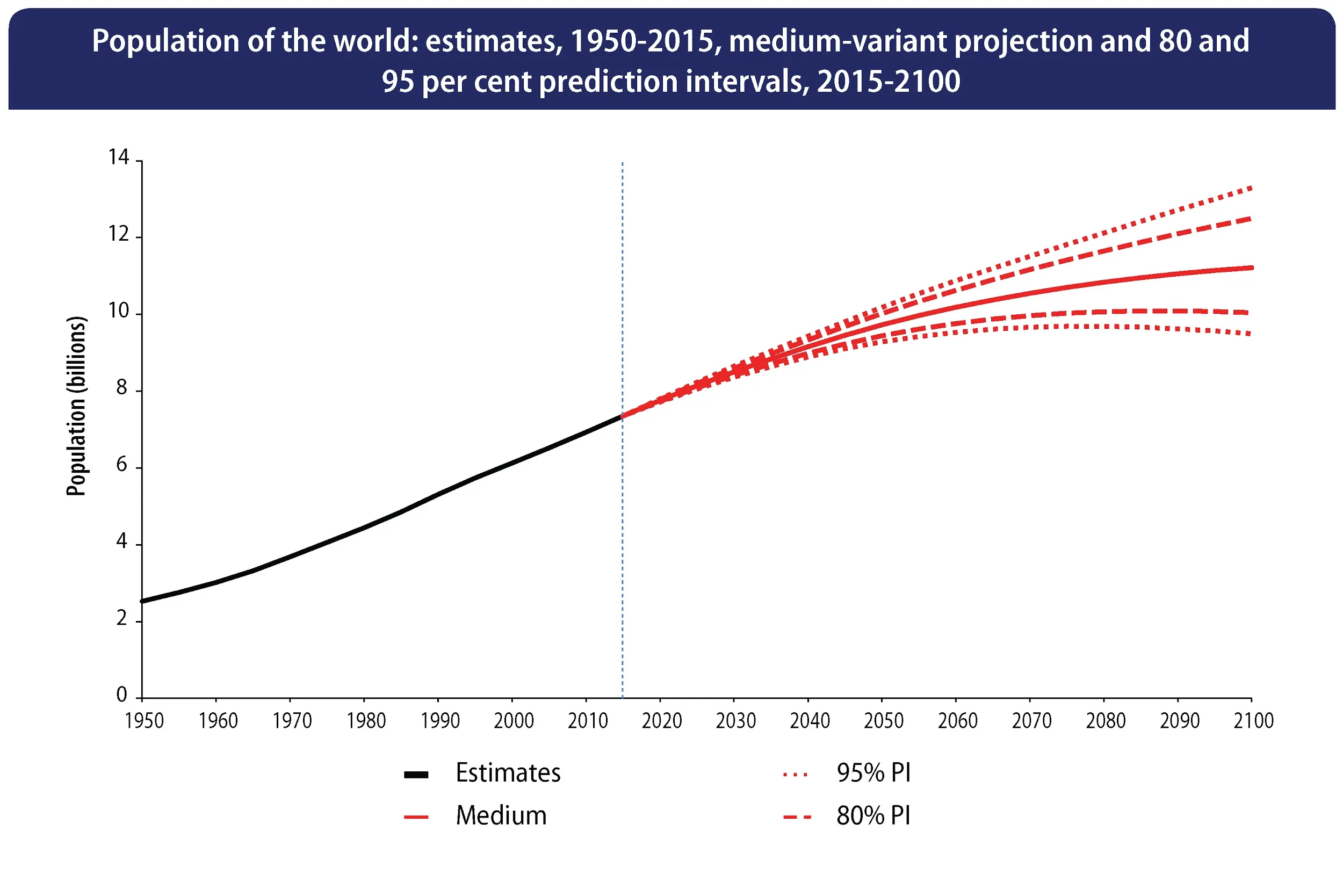
Fig 3. Population of the world: estimates, 1950-2015, medium-variant projection and 80 and 95 percent prediction intervals, 2015-2100.
So far, there have been only a few evidence-based projections of population change in the case of negligible senescence implementation. They show, however, that in the case of a gradually growing acceptance of technologies that may increase healthy longevity technologies, it would only compensate the depopulation trend observed now in developed countries. If negligible senescence is offered to everyone at once at the age of 60 or 40, there could be a population increase of 22% or 47%, respectively, during the next 100 years.
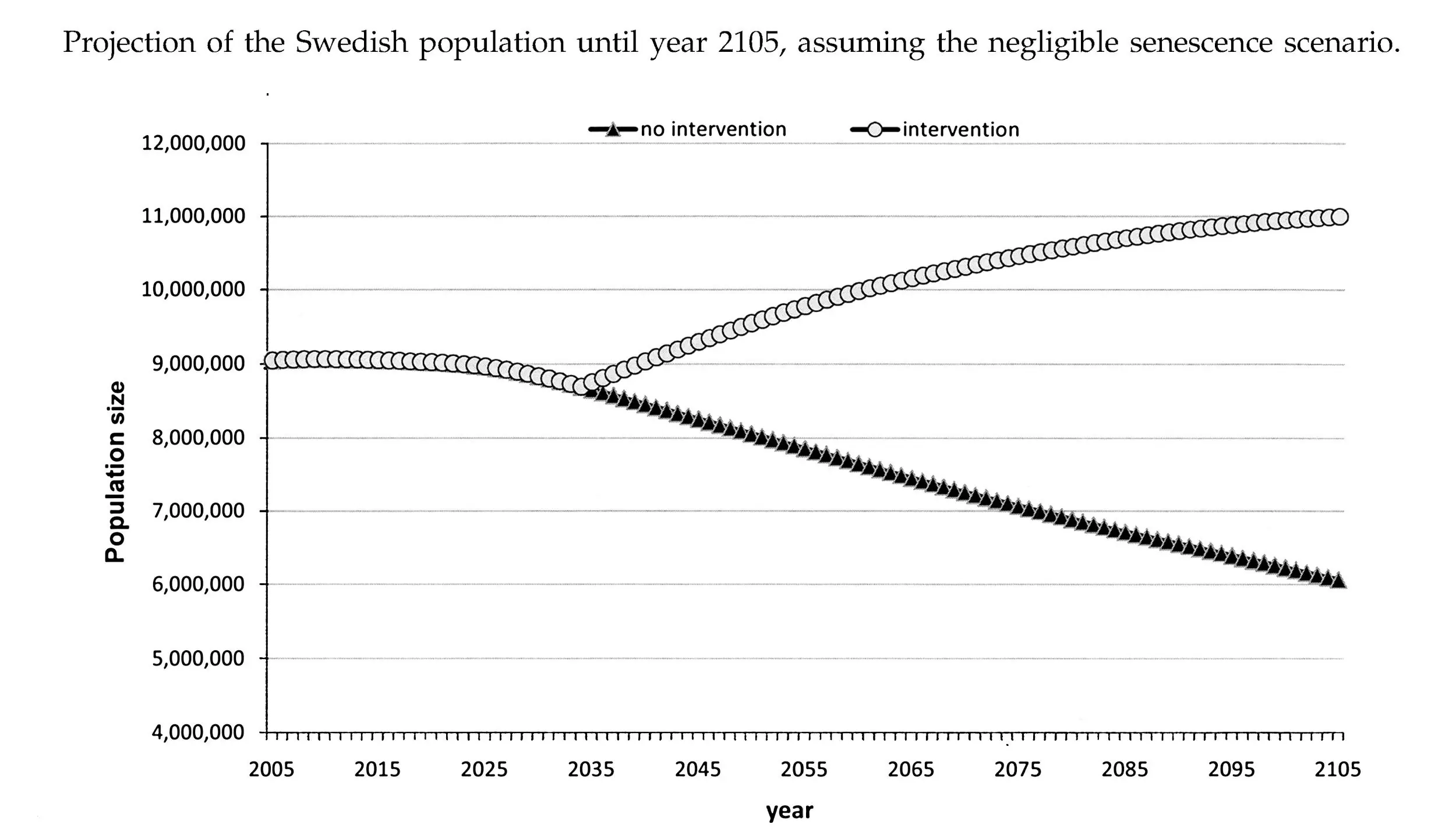
Fig 4. Projection of the Swedish population until year 2105, assuming the negligible senescence scenario.Increased healthy longevity interventions start at age 60 years, with a 30-year time delay from now [3].
This rate of population growth is significantly slower than the record one, which was observed back in the 60s and 70s when our population increased from 3 to 4 billion in just 14 years. At that time, thanks to the “Green Revolution” (rapid development of new agricultural techniques), we didn’t suffer from a global food shortage.
Today, there are only a few regions in the world still suffering from malnutrition, and the severity of the problem is fading. This trend will very likely continue, and global society is likely to eradicate hunger completely by 2030. It is important to note that any persisting world hunger is not caused by global food underproduction but rather by administrative incompetence of local governments, wars, and natural disasters.
To adapt to a negligibly senescent society in the future, however, we will have to modify our food production approaches to fit within the carrying capacities of our ecosystem. According to a report by the Food and Agriculture Organization of the United Nations, “Livestock’s long shadow”, in 2006, livestock represented the biggest of all anthropogenic (i.e., due to human activity and with potentially harmful side effects) land uses, taking up to 70% of all agricultural land and 30% of the ice-free terrestrial surface of the planet [4].
The report states that livestock is responsible for about 18% of global warming, 9% of total carbon dioxide emissions, 37% of methane, and 65% of nitrous oxide. Water use for livestock represents about 8% of all human water use (7% of this being used for feed irrigation). The need for change has been already claimed by global society, which is stimulating the scientific community to come up with solutions.
Interestingly, we can already witness sustainable agricultural techniques appearing in the forms of hydroponics, aquaponics, vertical farming, lab-grown meat, synthetic milk, and many other things that need more energy but much less water and territory [5] and are much more environmentally friendly. Eventually, these techniques will supersede agriculture as we know it while providing us with enough food to feed the world.
To summarize, depending on the efficacy of interventions for increased healthy longevity, the period of health will be extended (while the period of illness will remain of the same length) or people will remain healthy and productive during their entire lives, potentially indefinitely. Most of the population would be able to work and hence support the development of the economy.
The burden of age-related diseases would likely be reduced, and some budget money could be redistributed to support lifelong education. Population will grow in any scenario, which will demand the reshaping of the food production industry and consumption policies to cause less burden on the environment. However, the increase in the workforce and, overall, human knowledge will likely help us solve any emerging problems more quickly.
Now that we have a clear picture of what the consequences of increased healthy longevity could be for society, would we identify medical control of aging processes and increased healthy longevity as bad things?
In what ways does nature increase lifespan?
Let’s consider a new question: should we regard increased healthy longevity as something completely unnatural, or could nature and evolution bring us to the same result, given time?
 There are at least two species in the animal world whose lifespans have been naturally extended far beyond the lifespans of their close cousins. These animals are the naked mole rat and Brandt’s bat. Here is what we know about how this increase of lifespan has happened.
There are at least two species in the animal world whose lifespans have been naturally extended far beyond the lifespans of their close cousins. These animals are the naked mole rat and Brandt’s bat. Here is what we know about how this increase of lifespan has happened.
The naked mole rat is a rodent similar in size to a mouse. Unlike mice, whose typical lifespan is around 2,5 years, mole rats live about 28-30 years in a system of deep tunnels where they are very well protected against predators.
In other species, predators and natural phenomena are factors that help to drive selection of the strongest and most adaptable to shape the next generation. As there were no external causes of death for naked mole rats, the best path to further improvement was to work on their endurance.
As you may already know, most animals reproduce until very old age and stop reproducing not long before they die [6]. An animal’s number of possible descendants is defined by the speed of its reproduction cycle and its lifespan. The most healthy mole rats were those that lived longer and thus created more offspring.
Over time, the genes of rat “centenarians” started to dominate in the population, contributing to an increase of lifespan in this species. While other species were developing strong pads, claws or wings, naked mole rats were developing better health. It is interesting to note that naked mole rats have also found a way to fight cancerous cells in their bodies, so their cancer incidence is significantly lower than that in their cousins [7].

Some species of bats have a similar story regarding their long lifespans. The insect-eating Brandt’s bat (Myotis brandtii) is the longest-lived bat species known to date: it can live up to 41 years. As these animals are very small (adult body weight of 4 to 8 grams), they represent the most extreme example of disparity between body mass and longevity among mammals [8].
As Brandt’s bat lives in caves, where it is well protected against predators and weather, natural selection has supported the lifespan extension of this species.
However, there might be other factors contributing to this change. For instance, these bats eat small and rather fast flying insects, which is why smaller individuals likely have adaptation benefits compared to bigger ones. Natural selection could promote a deficiency of growth hormone, which is known to play a role in reducing cancer incidence in many species and hence contributes to increased healthy longevity.
What can these “experiments” of nature teach us?
First, endurance and good health throughout the life of an individual is within the goals of nature for different reasons. Second, nature improves health by iteration and in relation to the conditions of the environment. It creates “prototypes”, and if the new features are beneficial for survival of the species, they remain recorded in a species’ DNA for further reproduction.
In a way, nature is constantly running its own clinical trials to see what genetic modifications are the best. Body form and health are only some of the modifiable elements that nature experiments with. It can also adapt behavior and how an animal interacts with the environment to increase its chances of survival and procreation – basically, this is how we humans developed our skilled hands and the ability to communicate in a sophisticated way.
The naked mole rat is an expert at digging complex systems of secure tunnels; Brandt’s bat developed echolocation and hibernation and reduced its size. These are examples of how nature has experimented and selected positive changes to optimize health and survival.
As humans, we are constantly improving our situation, making ourselves less dependent on the environment, exposing ourselves to fewer dangers (like predators and weather), and improving our survival odds. There is a possibility that nature will promote increased healthy longevity as well if left to work for another ten thousand years, but this is obviously far too slow to be of benefit to those of us reading today.
And even if we decided to let nature take thousands of years to increase healthy longevity, medical development and other factors related to civilization interfere with the processes of natural selection, so the natural development of increased healthy longevity may not happen this way, hence we will have no choice but to achieve the same results using science and technology.
But will the road to increased healthy human longevity be as safe as that resulting from natural selection?
Natural selection versus scientific research and medical intervention
Like nature, when we meet a specific challenge, we have to overcome it if we want to prosper and improve as a species. Our current challenges are an aging population, increasing morbidity of age-related diseases, and high expenditures for healthcare and pensions that are menacing the global economy. Again like nature, we come up with a prototype; we test different interventions in people to see if we can prevent or cure an age-related disease and extend the period of health, fertility, and professional productivity.
We measure the results the same way nature does: we see if the intervention helped an individual to be healthier and live longer or not. Like nature, we record the results of each iteration to find the most promising prototype and to reproduce it in all the population once it is certainly beneficial.
The three main principles that nature is using – testing a prototype, recording and assessing the results, selecting the best prototype for further reproduction – are observed by medical science. The only difference here is that nature is testing new features blindly through generations, while we can make an experiment in controlled conditions and extract necessary information much faster. Genetic engineering of plants in comparison to slower breeding and selection is a good example of how we can achieve exactly the same change in a much shorter time.
Every intervention to address the aging processes is going to go through our sophisticated system of quality, safety, and efficacy control: clinical trials. Initially, the treatment is tested in animals to find out its toxicity characteristics. If the benefits outweigh the possible adverse effects, the treatment is tested in healthy volunteers in stage one to see its effects on the human body. Stage two involves bigger groups and tests the therapy in people having the specific disease that it is supposed to treat, which is helpful to find the best dosages and the possible side effects in relation to dosage.
Stage three is a final check on large groups to confirm effectiveness of the treatment, reveal any side effects, compare it to commonly used treatments, and improve safety of usage. Only after it is proven that the new treatment is effective and safe enough can it be registered and enter the market. Even then, the surveillance does not stop; data about the application of the new treatment is carefully collected in order to allow further adjustment of prescription conditions and usage.
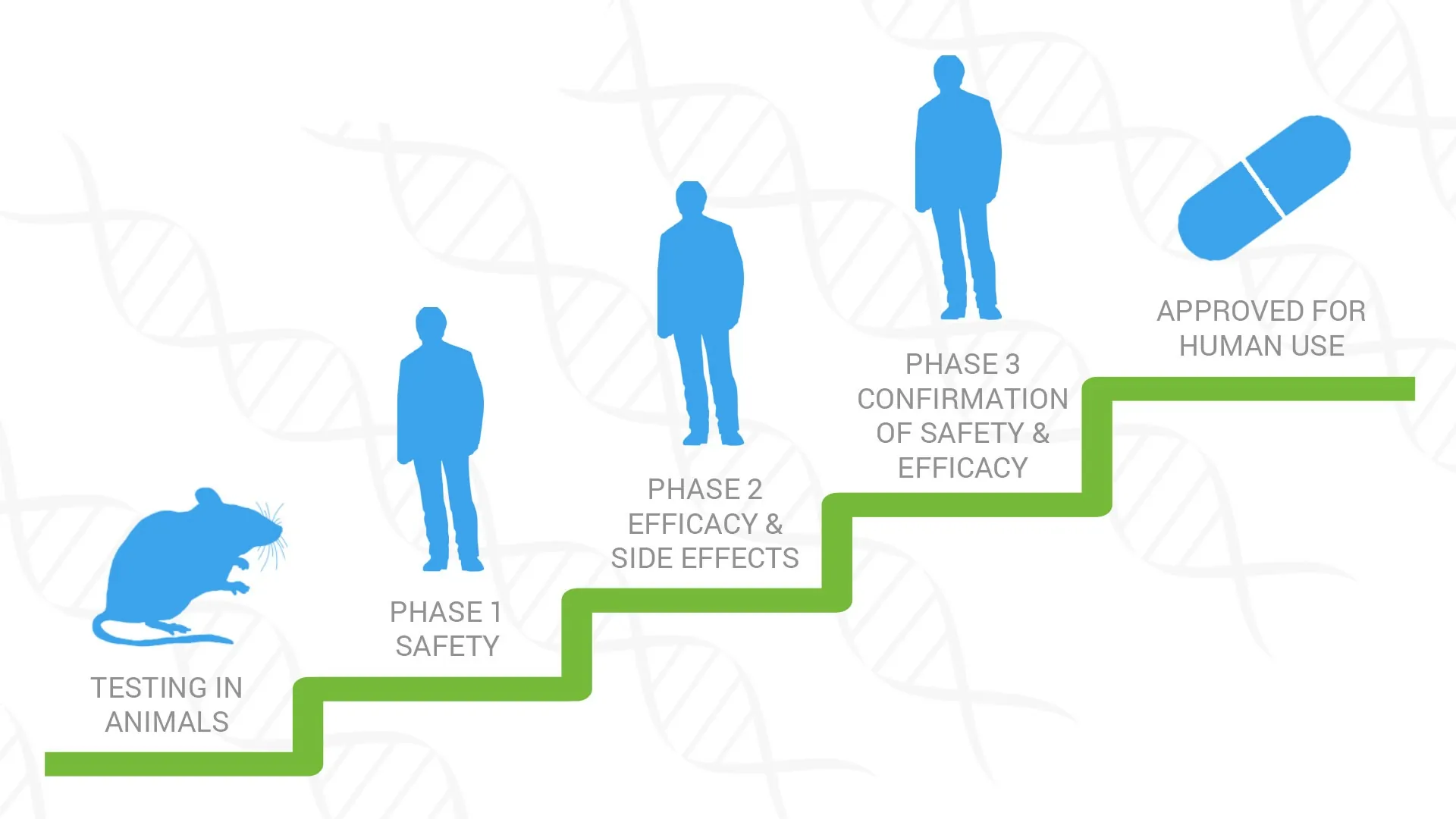
Fig 5. The clinical trial process for new drugs and therapies.
This approach ensures that the new treatment provides consistently reproducible results. This is why antibiotics are effective against microbes and vaccines are so good at preventing infectious diseases. Other types of treatment – surgery, healthy diet, cancer immunotherapy, even in vitro fertilization – are all being carefully tested to be beneficial before becoming massively implemented.
Either way, whether we are changed through natural selection or innovative biomedical technologies’ development and application, we don’t know for sure what the long-term consequences for our species will be. What we can say for sure is that we are going to change to become more adapted to the environment, as this is what evolution is all about.
Where is the border between medicine that we embrace and medicine that we reject?
We have always sought ways to protect our health and extend human lifespan. However, there are things that already existed when we were born and things that appeared only later. Most people would not consider washing their hands, taking medicines or having surgery as being unnatural or unethical, because we are used to their existence. However, these are ways to extend life.
 We tend to feel anxious when we encounter something new, like the idea of intervening in the aging processes. Part of this reaction is biologically programmed, as during human evolution, new things might turn out to be dangerous; another part is related to the deficiency of knowledge about new interventions and the indirect consequences of their application.
We tend to feel anxious when we encounter something new, like the idea of intervening in the aging processes. Part of this reaction is biologically programmed, as during human evolution, new things might turn out to be dangerous; another part is related to the deficiency of knowledge about new interventions and the indirect consequences of their application.
In case of need, such as the need to cure a severe and aggressive disease, we welcome even radical interventions such as gene therapy [9], because we know for sure that the alternative is probably death, and few things are worse than that.
However, the various aging processes lead to the development of deadly diseases [10], including cancer, Alzheimer’s, Parkinson’s, heart disease, and stroke, which makes any attempts to bring these processes under medical control highly ethical. A number of researchers are currently debating if aging should be considered a disease or a syndrome itself [11], and some researchers suggest including aging as a disease under the International Classification of Diseases.
If aging were classified as a disease in the next iteration of the ICD, this could create an opportunity for the medical industry to test and register new interventions for addressing the aging processes. This would then allow healthy middle-aged patients to use these interventions, even in the absence of age-related diseases, in order to prevent or postpone their manifestation.
This is part of a new movement in healthcare sometimes referred to as “preventative medicine”.
Methods such as regenerative medicine, rejuvenation biotechnology, immunotherapy, gene editing, stem cell therapy, and geroprotective pharmaceuticals are all ways to prevent and treat severe age-related pathologies, including cancer, cardiovascular disease, COPD, Alzheimer’s, Parkinson’s, hypertension, amyloidosis, type 2 diabetes, vision and hearing loss, and osteoarthritis. These treatments follow the principles that medicine always has followed: to cure diseases, ease suffering, and restore health. Any increased lifespan as a result is just a consequence of health improvement.
Increased healthy longevity, religion, and law
This discussion would not be complete if we did not touch upon the attitude of religion towards medicine. It is often explained in Christian catechism in relation to the Fifth Commandment. This Commandment instructs people not to kill, but as well as this direct demand, people must also not commit suicide or cause the death of others through willful neglect. This implies that if there is a means to help oneself or other people to avoid harm, disease or death, this means should be used.
The only time when the non-usage of medicine is not considered a sin is when an individual does not know about its existence or cannot obtain it. This is exactly why religious leaders of many traditions endorse the development of medicine. Life and health are valuable. To not use known and available methods to treat a deadly disease for oneself is equal to suicide, and not letting another individual use them is akin to murder.
What about secular law? Legal systems absorbed and codified many regulations of human relationships derived from religious traditions. Therefore, it is no surprise that the denial of medical assistance resulting in the death of a patient, dependent relative, or a child is identified as murder, and people who commit this are punished.
Conclusion
As so-called technologies that seek to increase healthy longevity are no more than medical technologies focused on preventing age-related diseases at an early stage and to sustain health throughout life, it is obvious that they should be considered the same as any other form of medicine and are no more unnatural than those we already use today.
The development of medical technologies, their implementation, and the efforts to make them accessible and affordable to every human being reflect the universal goal of the continuous improvement of health, which is embedded in international treaties such as the World Health Organization Constitution and the Declaration for Human Rights.
Literature
[1] Blagosklonny, M. V. (2012). How to save Medicare: the anti-aging remedy. Aging (Albany NY), 4(8), 547-52.
[2] Dong, X., Milholland, B. & Vijg, J.(2016). Evidence for a limit to human lifespan, 10.1038/nature19793.
[3] Gavrilov, L. A., & Gavrilova, N. S. (2010). Demographic consequences of defeating aging. Rejuvenation research, 13(2-3), 329-334.
[4] FAO, U., & Steinfeld, H. (2006). Livestock’s long shadow: Environmental issues and options. Rome:[sn].
[5] Barbosa, G. L., Gadelha, F. D. A., Kublik, N., Proctor, A., Reichhelm, L., Weissinger, E., … & Halden, R. U. (2015). Comparison of land, water, and energy requirements of lettuce grown using hydroponic vs. conventional agricultural methods. International journal of environmental research and public health, 12(6), 6879-6891.
[6] Croft, D. P., Brent, L. J., Franks, D. W., & Cant, M. A. (2015). The evolution of prolonged life after reproduction.Trends in ecology & evolution, 30(7), 407-416.
[7] Gorbunova, V., Seluanov, A., Zhang, Z., Gladyshev, V. N., & Vijg, J. (2014). Comparative genetics of longevity and cancer: insights from long-lived rodents. Nature Reviews Genetics, 15(8), 531-540.
[8] Seim, I., Fang, X., Xiong, Z., Lobanov, A. V., Huang, Z., Ma, S., … & Gerashchenko, M. V. (2013). Genome analysis reveals insights into physiology and longevity of the Brandt’s bat Myotis brandtii. Nature communications, 4.
[9] Calnan, M., Montaner, D., & Horne, R. (2005). How acceptable are innovative healthcare technologies? A survey of public beliefs and attitudes in England and Wales. Social Science & Medicine, 60(9), 1937-1948.
[10] Goldberg, E. L., & Dixit, V. D. (2015). Drivers of age‐related inflammation and strategies for healthspan extension. Immunological reviews, 265(1), 63-74.
[11] Bulterijs, S., Hull, R. S., Björk, V. C., & Roy, A. G. (2015). It is time to classify biological aging as a disease. Frontiers in genetics, 6.



